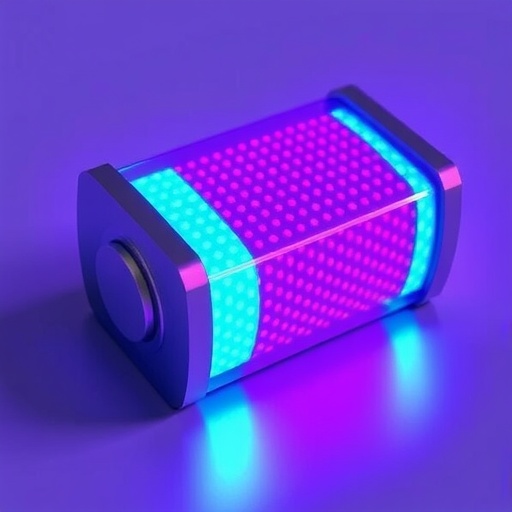
In a groundbreaking study published by Han, Ma, and Feng in “Ionics,” researchers have unveiled a novel composite material combining molybdenum disulfide (MoS₂) with nitrogen-doped carbon (NC) for use as an advanced anode in lithium-ion batteries. This work is pivotal as it seeks to address the increasing demand for more efficient and durable energy storage solutions. The rising significance of lithium batteries in electric vehicles and renewable energy sectors has driven the quest for materials that enhance the performance of these batteries while also ensuring environmental sustainability.
Lithium-ion batteries have undeniably transformed the energy storage landscape. Their lightweight nature, high energy density, and reusability make them ideal candidates for a variety of applications ranging from consumer electronics to electric vehicles. However, the performance of these batteries is inherently tied to the materials used in their electrodes. Traditional graphite anodes, while reliable, struggle to meet the ever-increasing demands for higher capacities and faster charging times. This has prompted researchers to explore alternative materials that can offer superior electrochemical properties.
In this study, the focus was directed toward the development of MoS₂/NC composites that not only exhibit enhanced electronic conductivity but also boast high surface area and structural stability. Molybdenum disulfide has emerged as an attractive anode material due to its layered structure, which facilitates the intercalation of lithium ions. The integration of nitrogen-doped carbon contributes to improved electrical conductivity, which is crucial for battery performance, particularly during rapid charge and discharge cycles.
.adsslot_WfEmKXsJ16{width:728px !important;height:90px !important;}
@media(max-width:1199px){ .adsslot_WfEmKXsJ16{width:468px !important;height:60px !important;}
}
@media(max-width:767px){ .adsslot_WfEmKXsJ16{width:320px !important;height:50px !important;}
}
ADVERTISEMENT
The synthesis of the MoS₂/NC composite was carefully designed to maximize the interaction between the two materials. The researchers employed a hydrothermal method, followed by calcination, to achieve a well-dispersed mixture that preserves the distinct advantages of both components. During the hydrothermal synthesis, the precursors reacted under controlled temperature and pressure, leading to the formation of MoS₂ nanostructures embedded within a nitrogen-doped carbon matrix. This innovative approach not only enhances the composite’s electrochemical properties but also maintains its structural integrity over numerous charge cycles.
Electrochemical examinations were conducted to evaluate the performance of the MoS₂/NC composite as a lithium-ion battery anode. The findings revealed remarkable improvements in specific capacity and cycle stability compared to traditional graphite anodes. Notably, the composite was able to accommodate a significantly higher capacity, showcasing its potential for next-generation battery applications. The results indicated a discharge capacity exceeding 1200 mAh/g after several hundred cycles—an impressive feat that positions MoS₂ as a leading contender in battery technology.
Moreover, the charge/discharge rates of the MoS₂/NC composite were also analyzed. The material demonstrated exceptional rate capability, allowing for rapid charging without a significant loss in capacity. This characteristic is largely attributed to the efficient electron transfer facilitated by the nitrogen-doped carbon, ensuring that lithium ions can be swiftly intercalated into the MoS₂ layers. Such performance metrics are vital for applications requiring quick charging solutions, such as electric vehicle batteries, where time is a critical factor.
The electrochemical stability of the MoS₂/NC composite was another focal point of this research. The researchers observed that the composite maintained its performance even after extensive cycling, indicating a high level of structural integrity. This robustness is essential for practical applications, as it translates to longer-lasting batteries with reduced degradation over time. The retention of capacity was consistent throughout the study, showcasing the potential for commercialization.
Furthermore, the study delves into the environmental implications of these innovative materials. With the growing concerns regarding the sustainability of battery materials, the move toward utilizing composites that combine abundant natural elements presents a much-needed approach. Molybdenum disulfide, being a transition metal dichalcogenide, is relatively abundant, and the incorporation of carbon—especially when doped with nitrogen—provides a pathway to enhance performance without resorting to rare or toxic materials. This aligns with contemporary research trends focusing on sustainable and eco-friendly alternatives in battery development.
Future work stemming from this research could explore the optimization of the synthesis methods to further enhance the performance of the MoS₂/NC composite. Investigating different carbon sources for nitrogen-doping and varying temperature profiles during synthesis could yield even more efficient materials. Additionally, researchers may look into integrating these composites with advanced electrolyte formulations to enhance the overall battery performance.
The potential applications of the MoS₂/NC composite extend far beyond conventional lithium-ion batteries. Given their superior electrochemical properties, such materials could be instrumental in the development of next-generation energy storage systems that rely on high-performance batteries. The emerging field of solid-state batteries, for example, could greatly benefit from composites that offer both safety and efficiency, owing to the enhanced performance metrics demonstrated by MoS₂/NC materials.
In summary, the research conducted by Han, Ma, and Feng represents a significant stride toward the evolution of lithium-ion battery technology. By synthesizing a MoS₂/NC composite that showcases not only excellent electrochemical properties but also sustainability, these researchers have laid the groundwork for future advancements in energy storage. As the world transitions towards a more energy-conscious era, innovations like this will be pivotal in shaping the future of how we store and utilize energy.
The ongoing demand for efficient, sustainable, and high-performance batteries highlights the crucial role of materials science in addressing global energy challenges. The integration of innovative materials such as the MoS₂/NC composite is not merely a scientific achievement but a necessary step in the collective journey toward cleaner energy solutions.
Subject of Research: Advanced anodes for lithium-ion batteries
Article Title: Synthesis and electrochemical properties of MoS2/NC composite as a novel anode for lithium battery.
Article References:
Han, Z., Ma, Z. & Feng, C. Synthesis and electrochemical properties of MoS2/NC composite as a novel anode for lithium battery.
Ionics (2025). https://doi.org/10.1007/s11581-025-06619-0
Image Credits: AI Generated
DOI: https://doi.org/10.1007/s11581-025-06619-0
Keywords: lithium-ion batteries, MoS₂, nitrogen-doped carbon, anode materials, electrochemical properties, energy storage, sustainable technology.
Tags: advanced energy storage solutionselectric vehicle battery technologyelectrochemical properties of anodeshigh-performance lithium-ion batteriesimproving battery charging efficiencyinnovative battery electrode materialslightweight battery technologieslithium battery anode materialsmolybdenum disulfide applicationsMoS2 nitrogen-doped carbon compositerenewable energy storage advancementssustainable battery materials





